1. 前言
大家好,我是若川。最近组织了源码共读活动,感兴趣的可以点此加我微信ruochuan12 参与,每周大家一起学习200行左右的源码,共同进步。已进行三个月了,很多小伙伴表示收获颇丰。
想学源码,极力推荐之前我写的《学习源码整体架构系列》 包含20余篇源码文章。
本文仓库 element-analysis,求个star^_^[1]
最近组织了源码共读活动,大家一起学习源码,每周学习200行左右的源码,已进行到13期。于是搜寻各种值得我们学习,且代码行数不多的源码。
其中 element-ui[2]新建组件的源码[3] 仅 100多行,非常值得我们学习。
可以通过 github1s.com 在线 VSCode 打开:https://github1s.com/ElemeFE/element/blob/dev/build/bin/new.js
阅读本文,你将学到:
1. 学会调试学习源码
2. element-ui 如何初始化新的组件
3. 可以学以致用应用到自己开发的项目中,比如新增页面等
4. 等等2. 环境准备
2.1 克隆
# 推荐克隆我的项目,保证与文章同步
git clone https://github.com/lxchuan12/element-analysis.git
# npm i -g yarn
cd element-analysis/element && npm run dev# 或者克隆官方项目
git clone https://github.com/ElemeFE/element.git
# npm i -g yarn
cd element && npm run dev2.2 看开源项目的 README 和贡献文档等
看开源项目,我们一般先看README,README.md[4] 中一般有贡献指南[5]。
开发环境搭建
首先你需要 Node.js 4+,yarn 和 npm 3+。注意:我们使用 yarn 进行依赖版本的锁定,所以请不要使用
npm install安装依赖。
git clone git@github.com:ElemeFE/element.git
npm run dev# open http://localhost:8085package.json
{"script": {"bootstrap": "yarn || npm i","build:file": "node build/bin/iconInit.js & node build/bin/build-entry.js & node build/bin/i18n.js & node build/bin/version.js","dev": "npm run bootstrap && npm run build:file && cross-env NODE_ENV=development webpack-dev-server --config build/webpack.demo.js & node build/bin/template.js",},
}在 npm run dev 时是先执行了 npm run bootstrap => yarn || npm i 命令,安装好了依赖。
npm run build:file 应该留着下一篇文章讲述。
组件开发规范
通过
make new创建组件目录结构,包含测试代码、入口文件、文档 如果包含父子组件,需要更改目录结构,参考Button组件内如果依赖了其他组件,需要在当前组件内引入,参考Select
make 命令的配置对应根目录 Makefile。
# element/Makefile
new:node build/bin/new.js $(filter-out $@,$(MAKECMDGOALS))通过查看 Makefile 文件我们知道了make new命令对应的是:node build/bin.new.js。
接着我们来调试源码。
2.3 调试源码
在最新版的 VSCode 中,auto attach 功能,默认支持智能调试,如果发现不支持,可以通过快捷键 ctrl + shift + p 查看是否启用。
ctrl + 快捷键打开终端。输入如下命令,即可调试build/bin/new.js`。
make new ruochuan 若川组件
# Ubuntu 和 Mac 支持 make 命令
# 不支持可以用 node
node build/bin/new.js ruochuan 若川组件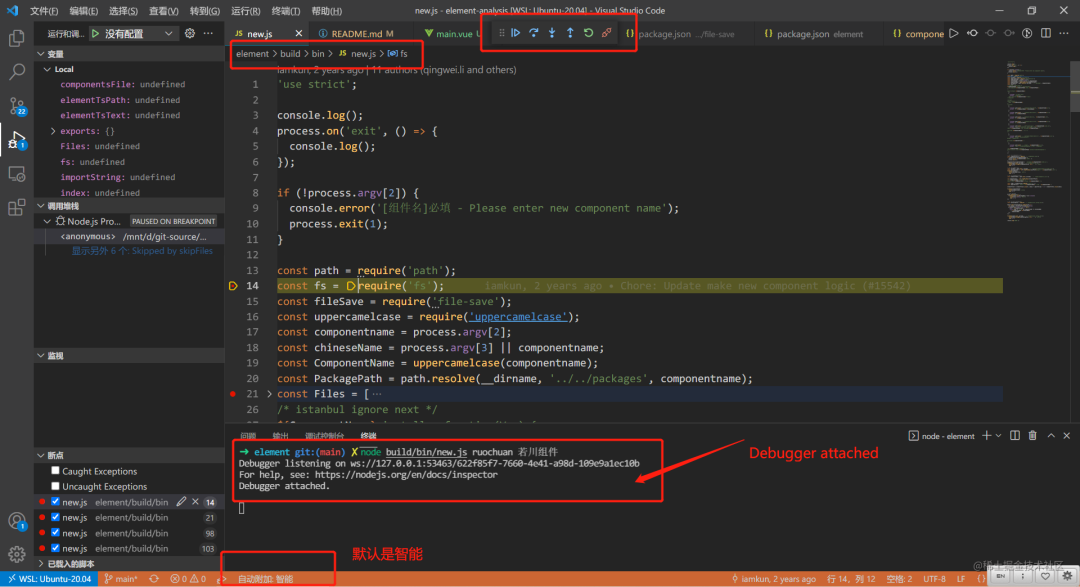
更多调试细节可以看我的这篇文章:新手向:前端程序员必学基本技能——调试JS代码
接着我们按调试来看主流程。
3. 主流程
我看完 build/bin/new.js 源码画了一张流程图。毕竟俗话说得好,一图胜千言。
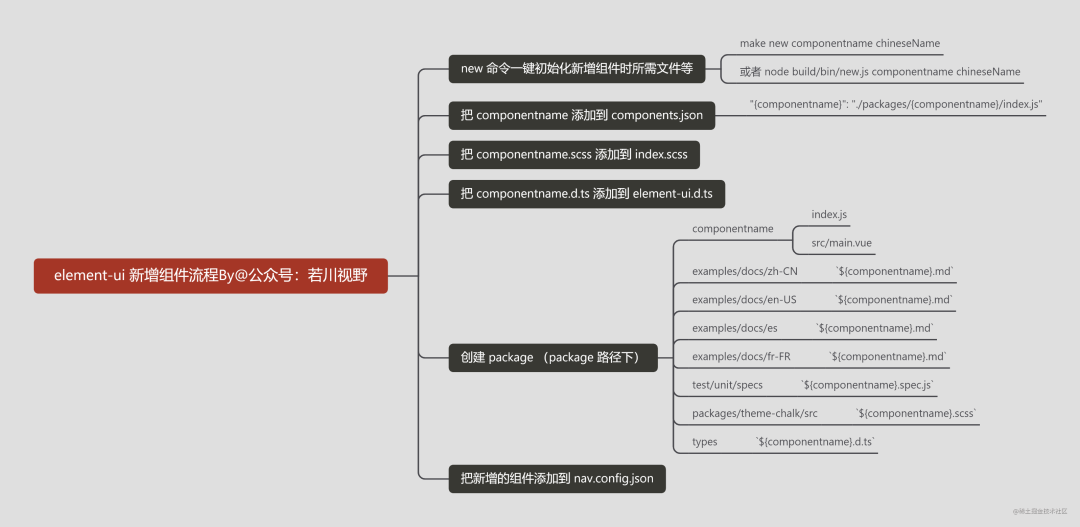
同时执行完命令后也新增和修改了若干文件,git diff 如下图所示。
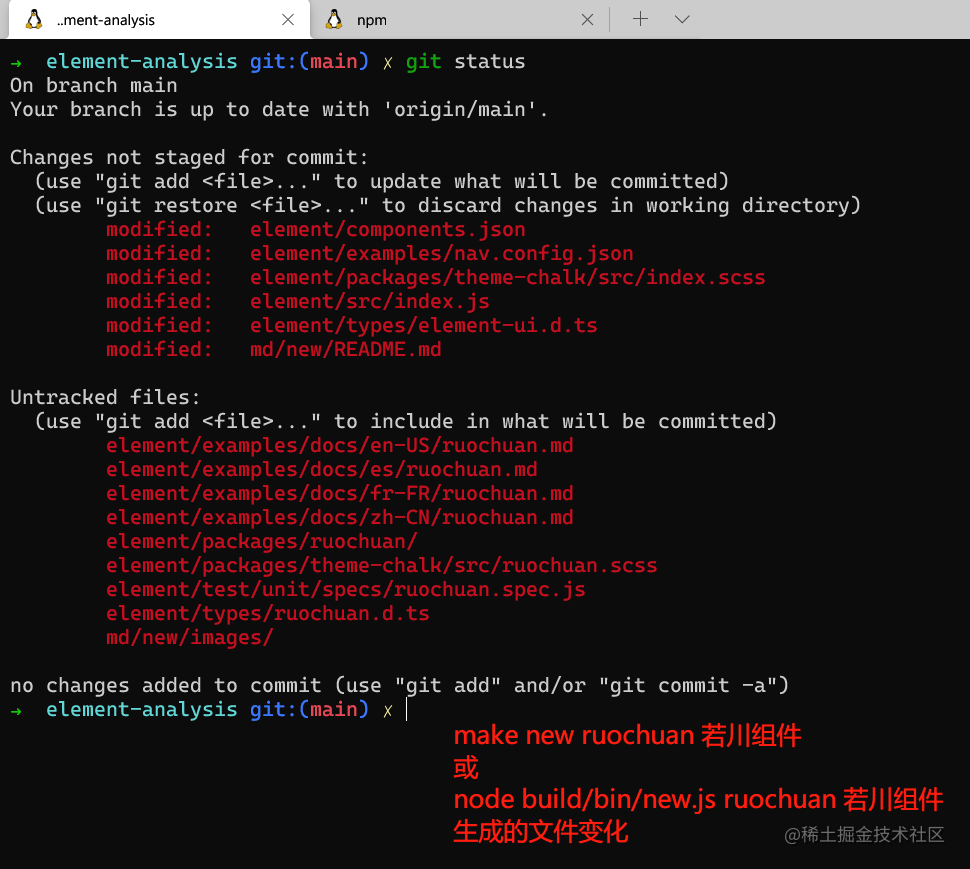
接着我们来看 build/bin/new.js 文件。
3.1 文件开头判断
'use strict';console.log();
process.on('exit', () => {console.log();
});// 第一个参数没传递报错,退出进程
if (!process.argv[2]) {console.error('[组件名]必填 - Please enter new component name');process.exit(1);
}关于 process 对象可以查看 阮一峰老师 process 对象[6]
process.argv属性返回一个数组,由命令行执行脚本时的各个参数组成。它的第一个成员总是node,第二个成员是脚本文件名,其余成员是脚本文件的参数。
接着我们来看,引用的依赖等。
3.2 引用依赖等
// 路径模块
const path = require('path');
// 文件模块
const fs = require('fs');
// 保存文件
const fileSave = require('file-save');
// 转驼峰
const uppercamelcase = require('uppercamelcase');
// 第一个参数 组件名
const componentname = process.argv[2];
// 第二个参数 组件中文名
const chineseName = process.argv[3] || componentname;
// 转驼峰
const ComponentName = uppercamelcase(componentname);
// package 路径
const PackagePath = path.resolve(__dirname, '../../packages', componentname);
// const Files = [];其中 file-save[7] 依赖,顾名思义,且非常关键。我们可以在 node_module/file-save 查看一些信息。也可以在 https://npmjs.com 搜索其信息。
接着,我们来看文件模板。定义了若干文件模板,方便写入到项目中。
3.3 文件模板 Files
const Files = [{filename: 'index.js',content: `import ${ComponentName} from './src/main';/* istanbul ignore next */
${ComponentName}.install = function(Vue) {Vue.component(${ComponentName}.name, ${ComponentName});
};export default ${ComponentName};`},{filename: 'src/main.vue',content: `<template><div class="el-${componentname}"></div>
</template><script>
export default {name: 'El${ComponentName}'
};
</script>`},
// 省略其他
];接着我们继续看添加对应的路径到组件 json 配置中。
3.4 把 componentname 添加到 components.json
// 添加到 components.json
const componentsFile = require('../../components.json');
if (componentsFile[componentname]) {console.error(`${componentname} 已存在.`);process.exit(1);
}
componentsFile[componentname] = `./packages/${componentname}/index.js`;
fileSave(path.join(__dirname, '../../components.json')).write(JSON.stringify(componentsFile, null, ' '), 'utf8').end('\n');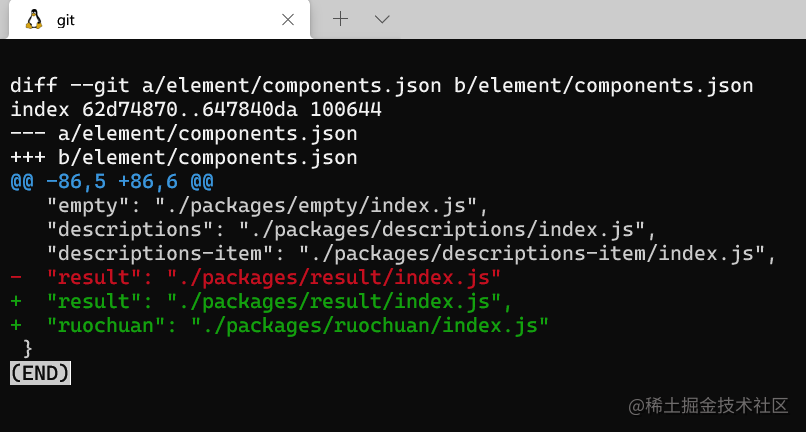
3.5 把 componentname.scss 添加到 index.scss
// 添加到 index.scss
const sassPath = path.join(__dirname, '../../packages/theme-chalk/src/index.scss');
const sassImportText = `${fs.readFileSync(sassPath)}@import "./${componentname}.scss";`;
fileSave(sassPath).write(sassImportText, 'utf8').end('\n');3.6 把 componentname.d.ts 添加到 element-ui.d.ts
// 添加到 element-ui.d.ts
const elementTsPath = path.join(__dirname, '../../types/element-ui.d.ts');let elementTsText = `${fs.readFileSync(elementTsPath)}
/** ${ComponentName} Component */
export class ${ComponentName} extends El${ComponentName} {}`;const index = elementTsText.indexOf('export') - 1;
const importString = `import { El${ComponentName} } from './${componentname}'`;elementTsText = elementTsText.slice(0, index) + importString + '\n' + elementTsText.slice(index);fileSave(elementTsPath).write(elementTsText, 'utf8').end('\n');3.7 创建 package
// const PackagePath = path.resolve(__dirname, '../../packages', componentname);
// 创建 package
Files.forEach(file => {fileSave(path.join(PackagePath, file.filename)).write(file.content, 'utf8').end('\n');
});
3.8 把新增的组件添加到 nav.config.json
const navConfigFile = require('../../examples/nav.config.json');Object.keys(navConfigFile).forEach(lang => {let groups = navConfigFile[lang][4].groups;groups[groups.length - 1].list.push({path: `/${componentname}`,title: lang === 'zh-CN' && componentname !== chineseName? `${ComponentName} ${chineseName}`: ComponentName});
});fileSave(path.join(__dirname, '../../examples/nav.config.json')).write(JSON.stringify(navConfigFile, null, ' '), 'utf8').end('\n');console.log('DONE!');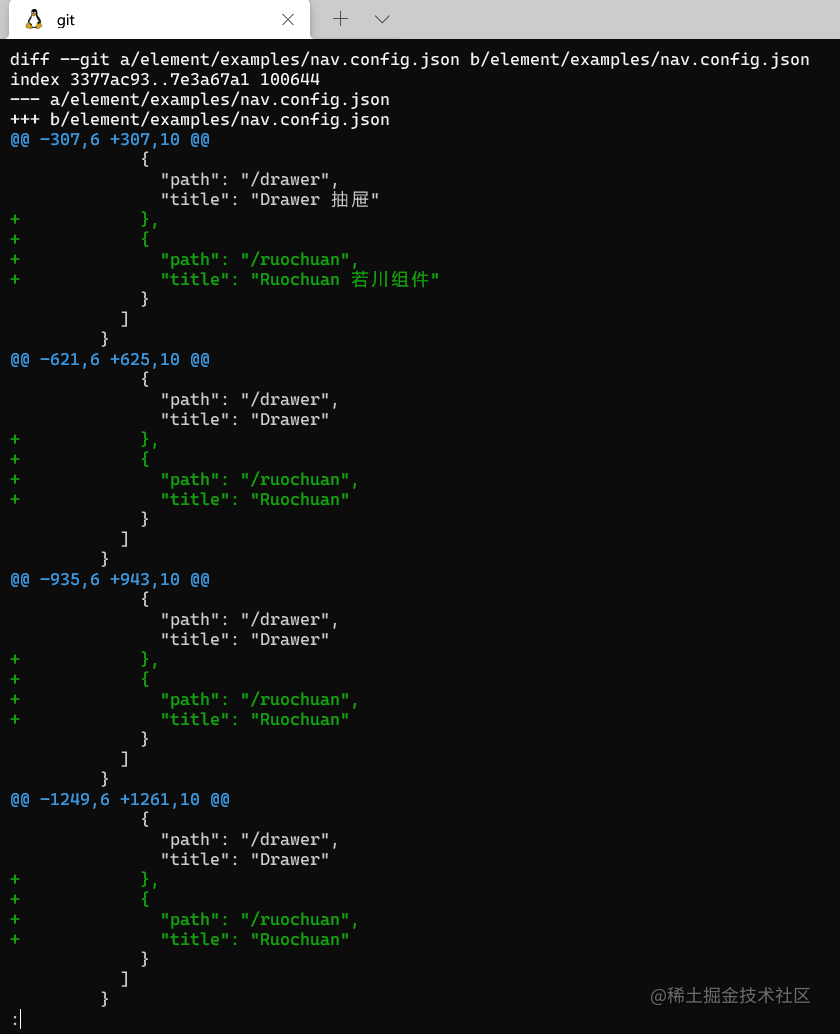
nav.config.json 的修改,新增的组件显示在导航这里。其中有四次修改是对应四种语言。
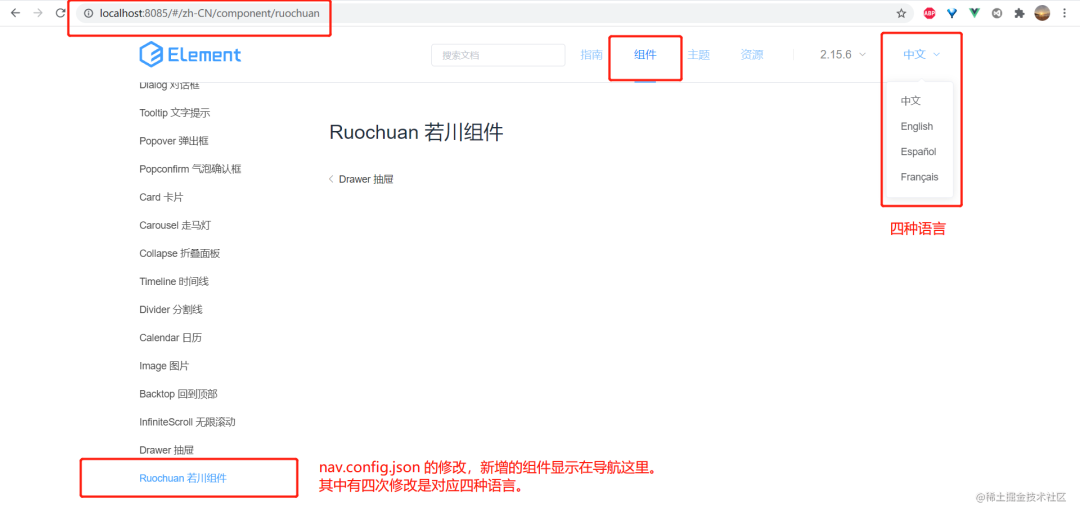
4. 总结
再次放出开头的流程图。
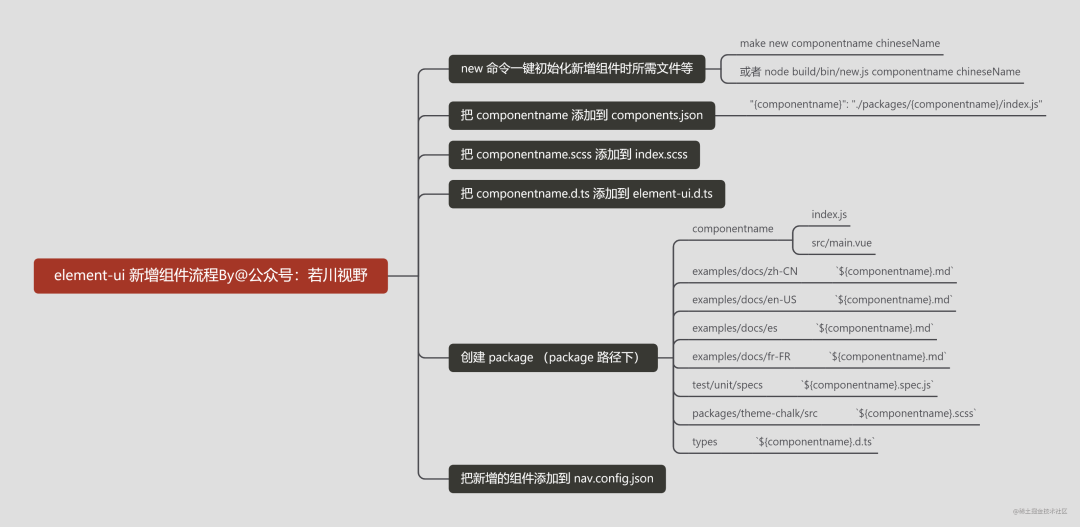
通过看 element-ui[8]新建组件的源码[9] 流程,我们学到了 file-save[10] 这么方便的写入文件的库等。
同时给我们启发:公司项目新建页面时,或者组件库新增组件时,是不是可以类似做到的,一条命令省去一些繁杂重复的操作。
建议读者克隆我的仓库[11]动手实践调试源码学习。
后续也可以查看 file-save[12] 源码实现等。
最后可以持续关注我@若川。欢迎加我微信 ruochuan12 交流,参与 源码共读 活动,大家一起学习源码,共同进步。
参考资料
[1]
本文仓库 element-analysis,求个star^_^: https://github.com/lxchuan12/element-analysis.git
[2]更多点击阅读原文查看
最近组建了一个湖南人的前端交流群,如果你是湖南人可以加我微信 ruochuan12 私信 湖南 拉你进群。
推荐阅读
1个月,200+人,一起读了4周源码
我历时3年才写了10余篇源码文章,但收获了100w+阅读
老姚浅谈:怎么学JavaScript?
我在阿里招前端,该怎么帮你(可进面试群)

················· 若川简介 ·················
你好,我是若川,毕业于江西高校。现在是一名前端开发“工程师”。写有《学习源码整体架构系列》10余篇,在知乎、掘金收获超百万阅读。
从2014年起,每年都会写一篇年度总结,已经写了7篇,点击查看年度总结。
同时,最近组织了源码共读活动,帮助1000+前端人学会看源码。公众号愿景:帮助5年内前端人走向前列。

识别上方二维码加我微信、拉你进源码共读群
今日话题
略。分享、收藏、点赞、在看我的文章就是对我最大的支持~

)



--JavaScript中的原型和类)













